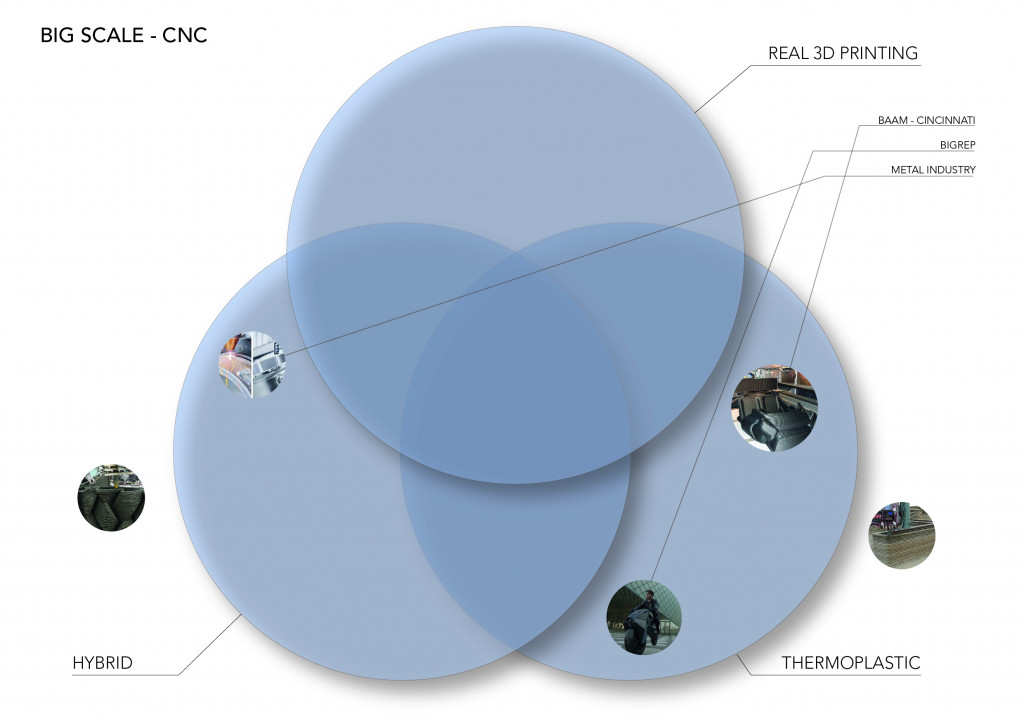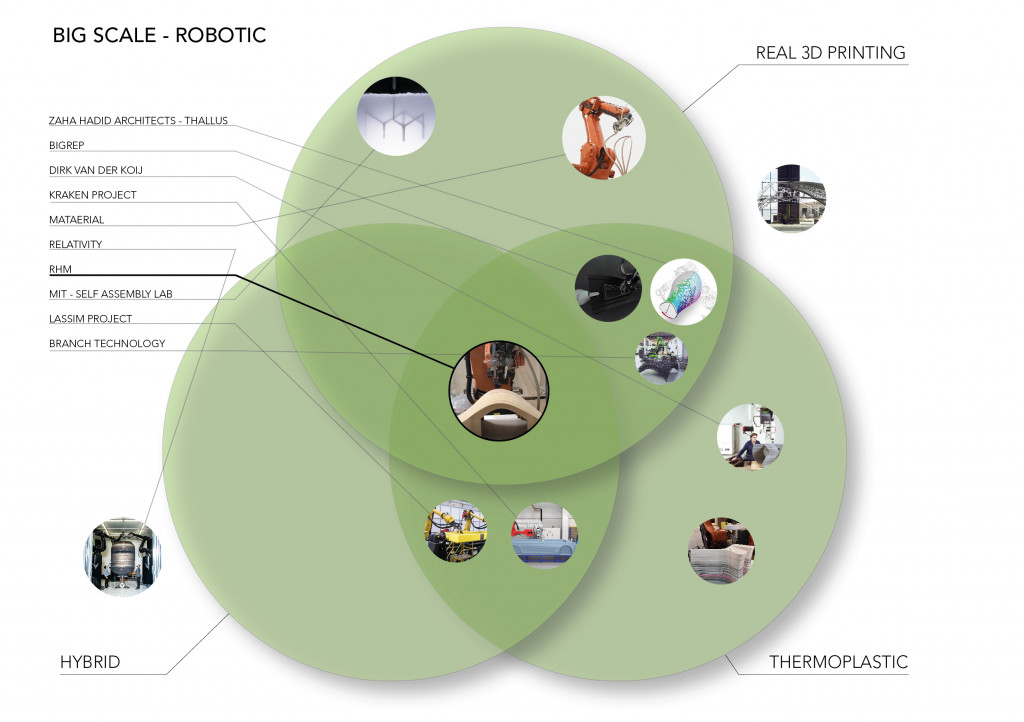INTRODUCTION
Hybrid Manufacturing, as it is simply the senseful combination of subtractive methods like cnc-milling and additive methods like 3D-printing in a fabrication system, has still reached the market in the metal industry. Other industries, handling with big scale 3d shapes, still try to improve fabrication speed, waste reducing or surface quality by focusing on just producing with one of these methods. The combination of both methods together with a robotic system with a huge freedom of movements and reach abilities could save time and waste and increase the quality and accuracy of big scale objects. Furthermore materials are needed which are hybridable, means they could be milled and also 3d-printed. In that case, thermoplastics, which are thrown as non compostable waste in a landfill are now the most interesting material for hybrid manufacturing. This paper is trying to reactivate the interest to thermoplastics as an important resource for creating a new kind of manufacturing big scale products. This paper tries to point out the economical relevance of a possible regional robotic setup, for fast production between unique and mass product.

ADDITIVE MANUFACTURING AND CNC-MILLING
In the direct comparison of both prototyping methods , the advantage of the one is mostly the disadvantage of the other method. In terms of accuracy and surface finish cnc-milling is much better than AM. Trying to reach a high accuracy and surface finish with AM means increasing the time of producing by having a decreased layer height. But that could effect the probability of printing errors like over- or underextrusion . But in terms of the amount of material for producing or the programming effort, Additive Manufacturing is much better.
So the combination of both methods could be the combination of all advantages of both in one system without any disadvantage.

So in the future of big scale manufacturing the desicion is not between AM or CNC-Milling , its more the question in which relation they both come together according to the part which should be produced.
HYBRID MATERIALS
For hybrid manufacturing it is neccessary to take materials which could be used for both methods. The metal industry is still working with hybrid manufacturing. But also thermoplastics and thermoplastic polyurethanes work for both methods.

Luckily the most problematic material for our enviroment today is one of the materials we could use. Thermoplastics are considered as the evil because we throw too much of them away and this material will stay for the next hundreds of years until it decomposes. But this material could be recycled many times without loosing too much physical properties. By heating up thermoplastics they melt and become reusable for additive manufacturing. And the waste of CNC-milling could be recycled again to new printing material.
All the problematic thermoplasts we find in oceans and landfills like PP (Polypropylene), ABS (Acetylbutadienstyrene ), PS (Polystyree), HDPE (High Density Polyethylene), LDPE (Low Density Polyethylene) and many more, are the most used thermoplastic materials for different industryfields where parts have to work longer then coffeecaps and foodpackages. So we can reuse all these materials a couple of times for the next decades while we develop bio-based thermoplasts to replace these petroleum-based once.

FRAMEWORK
For manufacturing big scale shapes we have to take a closer look into CNC-machines as well as in robotic systems. The big CNC-machines promise mostly more accuracy but are much more expensive, need a lot of space and have less freedom of axis the robotic arms. But in both cases we find companys tackling interesting fields like Real 3D-Printing (Multi-Axis-Additive Manufacturing), the use of thermoplastics and hybrid manufacturing. But there is no company which combines all 3 fields .


PROOF OF CONCEPT
As the proof of concept a double curved surface like a chair could not only proof the feasability of hybrid manufacturing in context of robotics and thermoplastics, we can also create a physical working prototype. On this shape we can proof if there is an economical relevance compared to unique and mass production as well as structural behaviors of multi-axis-printing and productlike surface finishing.

APPLICATIONS
If the chair could be archieved in a economical way , it could open the door to many applications which need big scale double curved surfaces, stable constructions and a high surface accuracy and detailing.



FUTURE
This research could lend into other different interesting research fields which could make the economical neccesity of hybrid manufacturing much more relevant.
We have to develop an AI based software which finds out on its own, whats the most efficient way between the both methods for every manufacturable piece. We have to create new slicing and milling strategies for multi-axis additive manufacturning according to the loads and needed strength and also time and waste of material. To print on existing surfaces could be also a very relevant topic in the future. Furthermore the idea of repairing existing obejcts via hybrid manufacturning could be a feasable goal and finally this setup of a multi-axis robotarm combined with a hybrid tool could lead to a regional production instead of decentralized international production.
FINALLY
With this approach we can get a step closer from :
PRODUCTION ORIENTED DESIGN to a DESIGN ORIENTED PRODUCTION
Theory & Context | MRAC 2018-2019
Faculty : Ricardo Devesa
Student : Sebastian Voigt